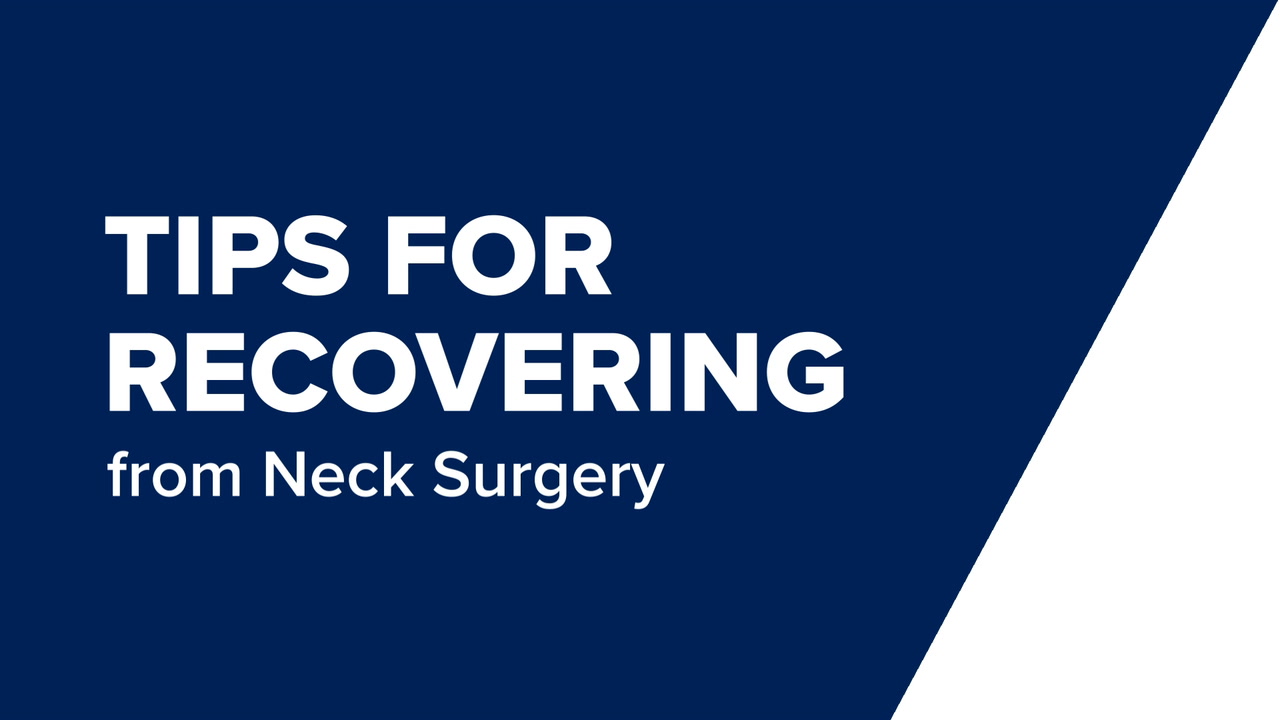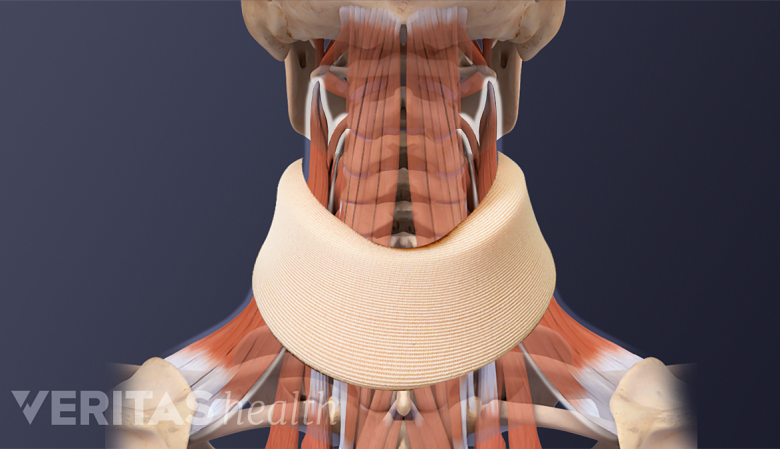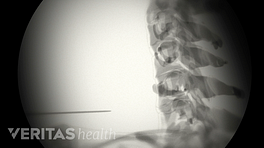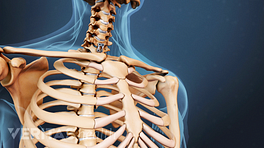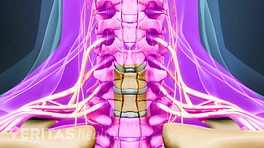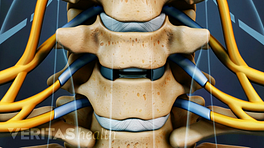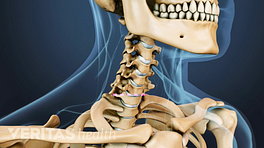It is normal to experience acute inflammation, muscle soreness, and incisional pain after surgery. Overall, average pain levels peak in the first 1-3 days following the surgery and then gradually improve over 2 to 6 weeks as swelling resolves and muscles heal. Some degree of aching, tightness, and soreness persists up to 6 months. 1 Prabhakar NK, Chadwick AL, Nwaneshiudu C, et al. Management of Postoperative Pain in Patients Following Spine Surgery: A Narrative Review. Int J Gen Med. 2022;15:4535-4549. Published 2022 May 2. doi:10.2147/IJGM.S292698
Strict adherence to prescribed activity restrictions decreases increased pain and protects the surgical site in its early healing stages.
The timeline for activity restriction varies based on the specific procedure, but most patients should expect at least 4 to 6 weeks of limited motion.
In This Article:
- Cervical Spine Surgery
- Pain Management and Activity Restrictions after Cervical Spine Surgery
- Potential Risks and Adverse Events Associated with Cervical Spine Surgery
Understanding Post-Surgical Pain
Anterior cervical approaches cause minimal trauma to the neck muscles.
The surgical approach plays a major role in determining the level of pain and discomfort after neck surgery.
- Muscle pain is lesser in anterior (front) approaches, such as anterior cervical discectomy and fusion (ACDF), because no muscles are cut during anterior surgery. Discomfort due to dysphagia (difficulty swallowing) is a common bothersome factor in anterior approaches. 2 Paziuk T, Rihn J. Cervical spine surgery: Complications and considerations. Seminars in Spine Surgery. 2019;31(4):100751. doi:10.1016/j.semss.2019.100751 , 3 Yee TJ, Swong K, Park P. Complications of anterior cervical spine surgery: a systematic review of the literature. J Spine Surg. 2020;6(1):302-322. doi:10.21037/jss.2020.01.14
- Muscle pain is more in posterior (back) approaches, such as posterior laminectomy, because the muscles are split to access the spinal column.
The intensity and duration of pain typically depend on the number of spinal levels treated, the patient’s health status, and response to pain medication.
Coping with Post-Surgical Pain
Managing pain at home includes a combination of medication, rest, therapeutic exercise, and activity modification.
Pain medications
NSAIDs alleviate neck pain by reducing inflammation and swelling.
Common drug categories for managing post-surgical pain include 1 Prabhakar NK, Chadwick AL, Nwaneshiudu C, et al. Management of Postoperative Pain in Patients Following Spine Surgery: A Narrative Review. Int J Gen Med. 2022;15:4535-4549. Published 2022 May 2. doi:10.2147/IJGM.S292698 :
- Opioids
- Nonsteroidal anti-inflammatory drugs (NSAIDs)
- Acetaminophen
- Muscle relaxers
- Nerve pain medications (gabapentinoids)
These medications are slowly weaned off over a period of 1 to 4 weeks as pain begins to decrease.
The ability to resume specific activities, like driving, depends on the tapering of certain medications, such as opioids.
Therapeutic exercise
Post-surgical rehabilitation includes 2 phases:
- Early mobilization through walking – which starts a few hours after the surgery
- Controlled physical therapy program – which generally starts 4 to 6 weeks after surgery 4 Barbosa TP, Raposo AR, Cunha PD, et al. Rehabilitation after cervical and lumbar spine surgery. EFORT Open Rev. 2023;8(8):626-638. Published 2023 Aug 1. doi:10.1530/EOR-23-0015
Neck strengthening exercises help reduce pain, improve balance, and prevent post-surgical complications.
Cervical bracing
A neck brace prevents excessive neck movement, aiding in healing and recovery.
During the initial 4-6 weeks of healing, some doctors recommend the use of a neck brace to restrict excessive movement of the healing spine. 4 Barbosa TP, Raposo AR, Cunha PD, et al. Rehabilitation after cervical and lumbar spine surgery. EFORT Open Rev. 2023;8(8):626-638. Published 2023 Aug 1. doi:10.1530/EOR-23-0015
Temporary Activity Restrictions after Cervical Spine Surgery
As the complexity of the surgery increases, surgeons prefer longer periods of activity restrictions. For example, after a single-level ACDF surgery, lifting light-to-moderate weight objects is permitted after 4 weeks, but the same timeframe increases to at least 6 weeks after a 3-level ACDF surgery. 5 Guglielmi GN, Seibly JM. Return to Work Guidelines Following Neurosurgical Procedures. Cureus. 2020;12(12):e11982. Published 2020 Dec 8. doi:10.7759/cureus.11982
Specific restrictions tailored to the surgery and individual are provided by the healthcare team.
General restrictions include:
- Lifting more than a certain weight, such as 8-10 pounds
- Bending and twisting the neck and waist
- Driving during the first 2 weeks after surgery 5 Guglielmi GN, Seibly JM. Return to Work Guidelines Following Neurosurgical Procedures. Cureus. 2020;12(12):e11982. Published 2020 Dec 8. doi:10.7759/cureus.11982 or until cleared by the doctor
- Avoiding strenuous exercise or high-impact sports for 8 weeks, lasting up to 12 months 5 Guglielmi GN, Seibly JM. Return to Work Guidelines Following Neurosurgical Procedures. Cureus. 2020;12(12):e11982. Published 2020 Dec 8. doi:10.7759/cureus.11982
- Avoiding sexual activity for the first 2 weeks
Additionally, activities that involve getting the surgical incision wet, such as hot tubs and baths, are avoided until the incision site completely heals and the sutures are removed.
Permanent Activity or Motion Restriction after Cervical Spine Surgery
The vast majority of individuals eventually resume most of their normal activities after cervical spine surgery. Some patients encounter permanent restrictions, including:
- Bending the neck after an extensive fusion surgery, which is more pronounced during forward and backward movement of the neck compared to turning the head from side to side.
- Inability to participate in certain high-impact sports after complex procedures (such as multi-level fusions) due to an increased risk of re-injury 6 Di Monaco G, Mazzucchi E, Pignotti F, La Rocca G, Sabatino G. Return to Martial Arts after Surgical Treatment of the Cervical Spine: Case Report and Systematic Review of the Literature for an Evidence-Based Approach. J Pers Med. 2022;13(1):3. Published 2022 Dec 20. doi:10.3390/jpm13010003
The extent of these permanent restrictions varies depending on the patient’s age, general health, and the type of surgery.
- 1 Prabhakar NK, Chadwick AL, Nwaneshiudu C, et al. Management of Postoperative Pain in Patients Following Spine Surgery: A Narrative Review. Int J Gen Med. 2022;15:4535-4549. Published 2022 May 2. doi:10.2147/IJGM.S292698
- 2 Paziuk T, Rihn J. Cervical spine surgery: Complications and considerations. Seminars in Spine Surgery. 2019;31(4):100751. doi:10.1016/j.semss.2019.100751
- 3 Yee TJ, Swong K, Park P. Complications of anterior cervical spine surgery: a systematic review of the literature. J Spine Surg. 2020;6(1):302-322. doi:10.21037/jss.2020.01.14
- 4 Barbosa TP, Raposo AR, Cunha PD, et al. Rehabilitation after cervical and lumbar spine surgery. EFORT Open Rev. 2023;8(8):626-638. Published 2023 Aug 1. doi:10.1530/EOR-23-0015
- 5 Guglielmi GN, Seibly JM. Return to Work Guidelines Following Neurosurgical Procedures. Cureus. 2020;12(12):e11982. Published 2020 Dec 8. doi:10.7759/cureus.11982
- 6 Di Monaco G, Mazzucchi E, Pignotti F, La Rocca G, Sabatino G. Return to Martial Arts after Surgical Treatment of the Cervical Spine: Case Report and Systematic Review of the Literature for an Evidence-Based Approach. J Pers Med. 2022;13(1):3. Published 2022 Dec 20. doi:10.3390/jpm13010003
